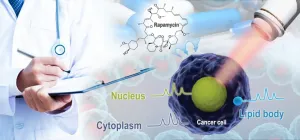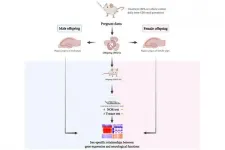Scientists present novel approach for monitoring freshwater health
Study describes how the world's smallest portable DNA sequencing device helps simplify the monitoring of bacteria in freshwater ecosystems
2021-01-19
(Press-News.org) Researchers have used the world's smallest, smartphone-sized DNA sequencing device to monitor hundreds of different bacteria in a river ecosystem.
Writing in the journal eLife, the interdisciplinary team from the University of Cambridge, UK, provide practical and analytical guidelines for using the device, called the MinION (from Oxford Nanopore Technologies), to monitor freshwater health. Their guidelines promise a significantly more cost-effective and simple approach to this work outside the lab, compared to existing methods.
Rowers and swimmers in Cambridge are regularly affected by waterborne infections such as Weil's disease, sometimes leading to public closures of the city's iconic waterways. Monitoring the microbial species in freshwater can help indicate the presence of disease-causing microorganisms and even water pollution. But traditional tests for freshwater bacteria often require well-equipped laboratories and complex methods for growing colonies of individual bacterial species.
"The direct measurement of all bacterial DNA traces in freshwater, an approach known as metagenomics, is a valuable alternative, but still requires large, expensive equipment that can be hard to operate," says Andre Holzer, co-first author and PhD student at the Department of Plant Sciences, University of Cambridge. "We aimed to describe the bacterial species present in the River Cam using the new portable DNA sequencing technology."
The team used the MinION device to sequence the DNA of entire groups of microorganisms found in water samples from the River Cam. But before they could use the sequence data, they needed to optimise their experimental methods and analysis software. "It was essential to account for the quality of this new type of bacterial DNA sequence information," Holzer explains. "We tested many different algorithms for processing the data to find the most accurate methods."
The researchers then used their optimised guidelines to analyse the data and successfully measure the proportions of hundreds of different bacterial species present in the water. They took samples from nine different sites along the river, often sampling the sites at three different time points so they could compare the proportions of species in different locations and seasons.
The team was also able to distinguish closely related, harmful microbial species from non-harmful ones. By comparing the samples from different locations, they found that there were more potentially harmful bacteria and those associated with wastewater downstream of the most built-up, urban areas of the river. Chemical follow-up analyses of the water samples collected from the same urban areas revealed a matching trend of increasing wastewater pollution in those areas.
"Our work shows how MinION and the associated DNA sequencing technology can be used in the effective monitoring of freshwater health," says Lara Urban, co-lead investigator of the work and now an Alexander von Humboldt Research Fellow at the University of Otago, New Zealand. "This expands on the technology's existing applications which include the accurate tracing of viral transmissions between patients during the recent Ebola, Zika and SARS-CoV-19 virus outbreaks."
"We hope our results will encourage other independent scientists and collectives to engage in simplified freshwater management and biodiversity tests around the globe,"concludes senior author Maximilian Stammnitz, a PhD student at the Department of Veterinary Medicine, University of Cambridge.
INFORMATION:
References
The paper 'Freshwater monitoring by nanopore sequencing' can be freely accessed online at https://doi.org/10.7554/eLife.61504. Contents, including text, figures and data, are free to reuse under a CC BY 4.0 license.
This study was supported by grants from the OpenPlant Fund (BBSRC), University of Cambridge RCUK Catalyst Seed Fund (Public Engagement Starter Grant), Natural Environment Research Council and Gates Cambridge Trust.
To find out more about the Punting & Sequencing (PuntSeq) project and the team behind it, visit http://www.puntseq.co.uk.
Media contact
Emily Packer, Media Relations Manager
eLife
e.packer@elifesciences.org
01223 855373
About eLife
eLife is a non-profit organisation created by funders and led by researchers. Our mission is to accelerate discovery by operating a platform for research communication that encourages and recognises the most responsible behaviours. We work across three major areas: publishing, technology and research culture. We aim to publish work of the highest standards and importance in all areas of biology and medicine, including Ecology and Microbiology and Infectious Disease, while exploring creative new ways to improve how research is assessed and published. We also invest in open-source technology innovation to modernise the infrastructure for science publishing and improve online tools for sharing, using and interacting with new results. eLife receives financial support and strategic guidance from the Howard Hughes Medical Institute, the Knut and Alice Wallenberg Foundation, the Max Planck Society and Wellcome. Learn more at https://elifesciences.org/about.
To read the latest Ecology research published in eLife, visit https://elifesciences.org/subjects/ecology.
And for the latest in Microbiology and Infectious Disease, see https://elifesciences.org/subjects/microbiology-infectious-disease.
[Attachments] See images for this press release:

ELSE PRESS RELEASES FROM THIS DATE:
2021-01-19
Whether consciously or unconsciously, automotive firms time their product recalls to minimize stock price penalties, resulting in unnecessary delays and clusters of subsequent recalls by other companies, according to new research from the University of Notre Dame.
An initial recall by one firm prompts clusters of additional recalls in close proximity by competitor firms, according to "Hiding in the Herd: The Product Recall Clustering Phenomenon," forthcoming in Manufacturing and Service Operations Management from Kaitlin Wowak, assistant professor of IT, analytics, and operations at Notre Dame's Mendoza College of Business.
According to the study, "Automobile recalls seem to be announced after inexplicable delays. Toyota's unintended acceleration recall and General ...
2021-01-19
Nearly 78 per cent of children with autism have at least one mental health condition and nearly half have two mental health conditions or more, according to a new U.S. study from the University of British Columbia's department of psychology and the AJ Drexel Autism Institute at Drexel University (Pennsylvania).
The study also found mental health conditions present in 44.8 per cent of pre-school age children with autism. The scope of the issue among that age group had not previously been established using a large, population-based sample.
By contrast, the study found that only 14.1 per cent of youth without autism (ages 3-17) had mental health conditions.
It is the first research since 2008 to examine the prevalence of mental health conditions among children with autism at a population ...
2021-01-19
Malta, a sovereign microstate in the middle of the Mediterranean Sea, has no shortage of sunny beaches, honey-bricked villages and rugged countryside. Beyond its Mediterranean charm, Malta is home to a geographically and culturally isolated population whose unique genetic makeup, makes this island nation a goldmine for genetics research.
Four years ago, the University of Malta set up a national ALS Registry and Biobank to identify patients with amyotrophic lateral sclerosis (ALS) and collect data on their residence, occupation, lifestyle and environmental exposures. Blood samples ...
2021-01-19
With the global student community taking online courses as a result of the anti-Covid-19 measures, a study led by the University of Geneva (UNIGE) reveals that online courses deepen inequalities between gifted and less gifted students by 5%. The results of the study, which was based on data collected in 2016-2017 prior to the anti-Covid lockdown initiatives, are published in the Journal of the European Economic Association. They indicate that this learning gap between different student profiles is mainly due to their behaviour and motivation. The study gives higher education establishments worldwide practical ways to deal with lockdown or the chronic lack of space in lecture theatres, including via co-educational ...
2021-01-19
Cancer cells are smart when it comes to anti-cancer drugs, evolving and becoming resistant to even the strongest chemotherapies over time. To combat this evasive behavior, researchers have developed a method named D2O-probed CANcer Susceptibility Test Ramanometry (D2O-CANST-R) to see, at single-cell/organelle level, how pharmaceuticals induce cancer cell death and how cancer cells adapt.
The research, conducted by the Qingdao Institute of Bioenergy and Bioprocess Technology (QIBEBT) of the Chinese Academy of Sciences (CAS), was published on Jan. 12 in Analytical Chemistry, ...
2021-01-19
A new study by researchers from Chulalongkorn University, Tohoku University, and The George Washington University is the first to identify autism candidate genes that may be responsible for the sex-specific effects of bisphenol A (BPA) on the brain. It suggests BPA may serve as an environmental factor that contributes to the prevalence of male bias in autism spectrum disorder (ASD).
The research was published in the journal Scientific Reports.
BPA is widely used in many products in our daily life and abundant in micro/nanoplastics found in the environment, ...
2021-01-19
Summary
Ultra-small nanomedicines of approximately 18 nm were fabricated by dynamic ion-pairing between Y-shaped block copolymers and nucleic acid drugs, such as siRNA and antisense drugs.
Chemically modified and double-stranded oligonucleotides dramatically enhanced the stability of the ultra-small nanomedicines in the blood circulation.
The ultra-small size allows for high permeability in cancer tissues by slipping through the cracks in tumor vasculatures and stromal tissues.
Clinical trials and preclinical studies using the developed ultra-small nanomedicines are proceeding for cancer therapy.
Published in the website of Journal of Controlled Release on January 6.
https://doi.org/10.1016/j.jconrel.2021.01.001
Main body
January 19, 2021 - Kawasaki in ...
2021-01-19
The survival of pesky little flies in showers and other wet areas around the house, impervious to water droplets that may be larger than they are, comes down to more than quick reflexes. The insects have evolved a unique coating of hairs that allows them to shrug off water droplets of almost any size, KAUST researchers have shown.
Sigurdur Thoroddsen, who leads the high-speed fluids imaging laboratory at KAUST, couldn't help but take a professional interest in the small drain flies that made a home in his shower and never seemed to wash away. Thoroddsen's research focuses on multiphase flow and dynamics at air-liquid interfaces -- an environment where drain flies have found a niche, despite some risky physics.
Insects are so small that the surface tension of ...
2021-01-19
What goes on in the sun can only be observed indirectly. Sunspots, for instance, reveal the degree of solar activity - the more sunspots are visible on the surface of the sun, the more active is our central star deep inside. Even though sunspots have been known since antiquity, they have only been documented in detail since the invention of the telescope around 400 years ago. Thanks to that, we now know that the number of spots varies in regular eleven-year cycles and that, moreover, there are long-lasting periods of strong and weak solar activity, which is also reflected in the climate on Earth.
However, how solar activity developed before the start of systematic records has so far been ...
2021-01-19
Every year around 734 million tons of wheat straw are produced worldwide, a large amount of waste, which is cheap and has had no well-defined use until now. Recently, the RNM-271 Chemical Engineering and FQM-383 NANOVAL Organic Chemistry research groups at the University of Córdoba have been able to give a new use to this agricultural excess material, by using it as the foundation in order to manufacture polyurethane foams.
Also known as foam rubber, this plastic material, often manufactured from petroleum by-products, is extremely versatile within the industry and has multiple uses in the construction and automobile sectors as a sealant as well as ...
LAST 30 PRESS RELEASES:
[Press-News.org] Scientists present novel approach for monitoring freshwater health
Study describes how the world's smallest portable DNA sequencing device helps simplify the monitoring of bacteria in freshwater ecosystems




